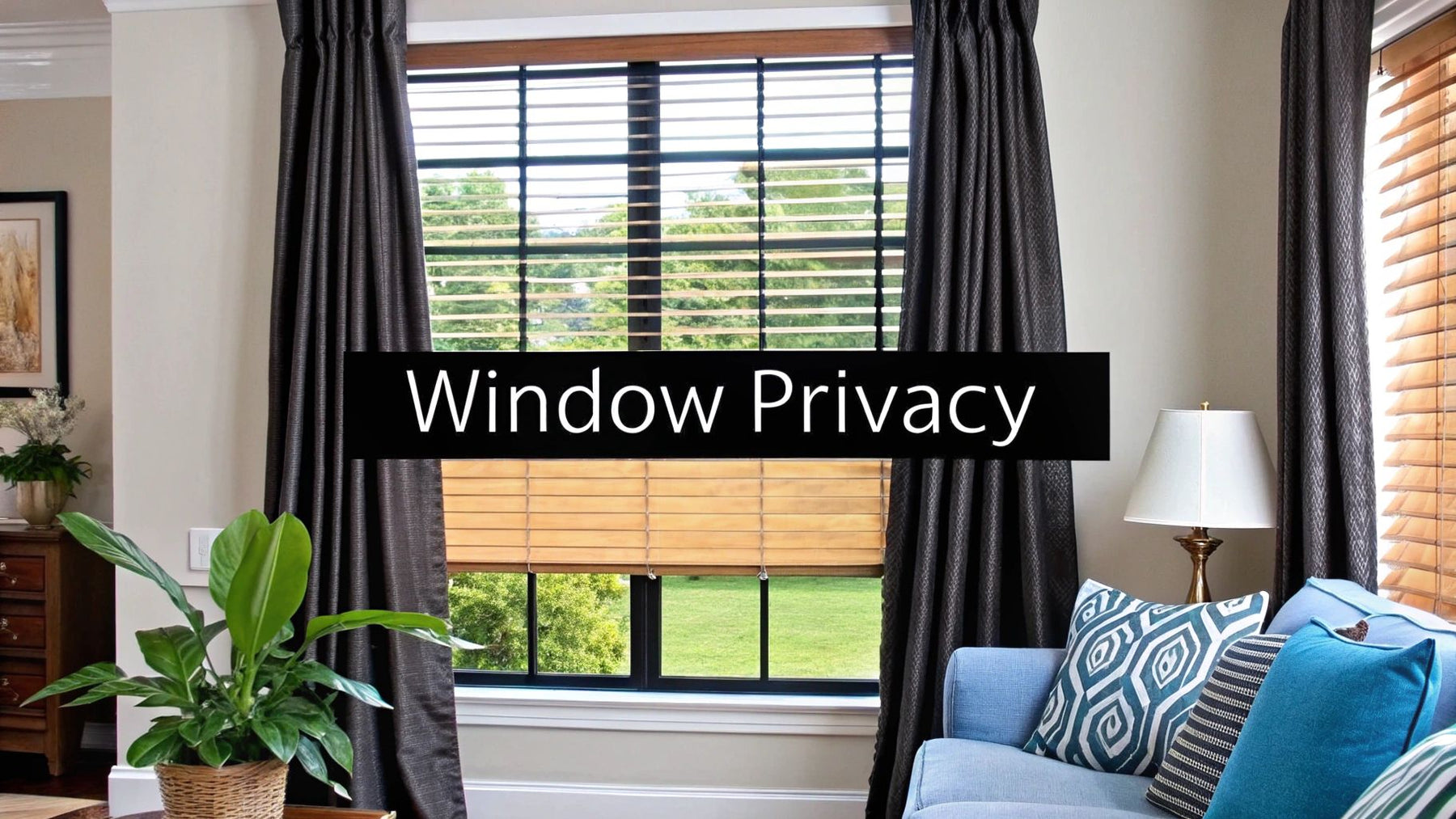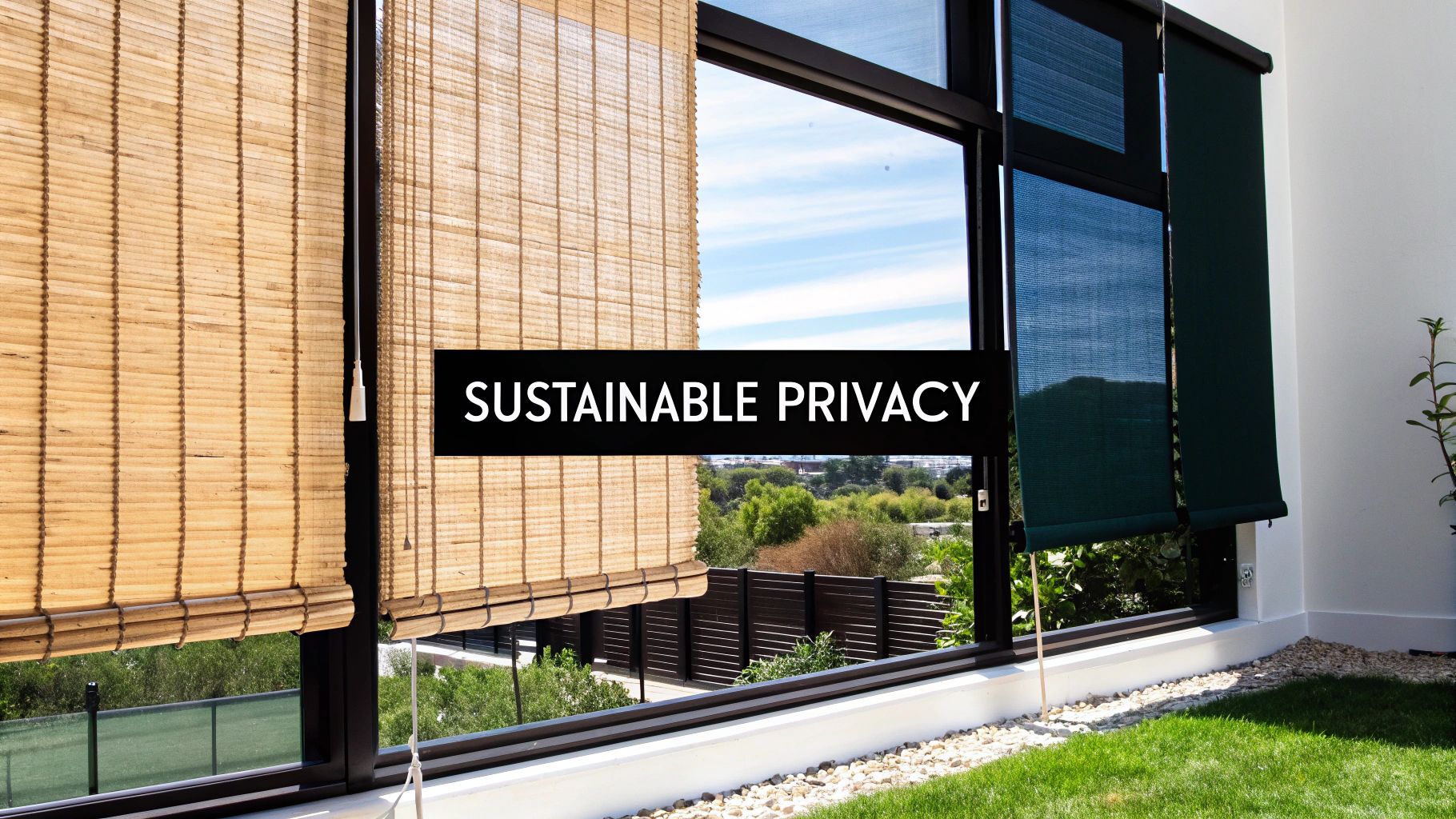
The Ultimate Guide to Window Treatments for Privacy
Striking the perfect balance between letting natural light in and keeping your personal space private can feel like a design puzzle. The best window treatments for privacy are those that solve this beautifully, offering both style and seclusion to turn any room into your sanctuary. From easy-to-adjust blinds to elegant curtains, finding the right fit comes down to your needs for light control and peace of mind.
This guide provides an expert look at the top solutions, helping you make an informed choice for every room in your home.
Table of Contents
- Why Window Treatment Choices Matter
- Understanding Privacy & Light Control Levels
- Comparing the Best Types of Window Treatments
- Using Smart Technology for Effortless Privacy
- Choosing Sustainable Materials for Your Home
- Frequently Asked Questions
Why Your Window Treatment Choice Matters
Choosing window treatments is more than a finishing touch; it’s a crucial decision that shapes your home's comfort and security. The right choice shields you from curious neighbors, protects furniture from UV damage, and can even improve energy efficiency. It’s about creating a space where you can truly relax, day or night.
This isn't just a small detail. The global window coverings market was valued at $34.5 billion in 2023 and is projected to hit $60.16 billion by 2030. This growth is fueled by a rising consumer demand for privacy and better light control. In fact, blinds and shades alone make up over 40% of this market, showing just how vital these solutions are for modern living.

Setting the Stage for Style and Seclusion
Before browsing products, consider what each room needs. Every space has unique requirements for privacy and light.
- What do bedrooms need? Bedrooms are personal retreats, so maximum privacy and light-blocking are key for restful sleep. A popular combination is layering blackout shades with decorative curtains.
- What about living rooms? These versatile spaces require flexible options. You'll want bright, natural light during the day but complete seclusion for a cozy movie night.
- What's best for bathrooms? The main challenge here is balancing privacy with moisture resistance. Faux wood blinds or durable vinyl shutters are excellent choices that won't warp or mildew.
- And for ground-floor windows? These are the most exposed to the outside, making privacy a top priority. Opaque or top-down/bottom-up shades are ideal.
The right window treatments also play a key role in enhancing interior aesthetics for real estate photography, making rooms feel more polished and inviting. The ultimate goal is a solution that looks incredible and gives you the peace of mind you deserve.
Understanding Privacy and Light Control Levels
Choosing the right window treatments isn't one-size-fits-all. The magic happens when you select the perfect level of privacy and light for each room. It's like tuning the atmosphere—sometimes you want a soft glow, while other times you need a completely dark, private retreat.
Understanding terms like "light-filtering," "room-darkening," and "blackout" is the first step. These aren't just marketing buzzwords; they describe exactly how a material manages sunlight and visibility. Getting this right ensures your living room won't feel like a cave and your bedroom won't be flooded with light at sunrise.
Light-Filtering: A Gentle Touch of Privacy
Light-filtering treatments are designed to blur the view from outside while letting a beautiful, diffused glow of natural light pour in. This creates a warm, welcoming ambiance without putting your home on display. The effect is similar to frosted glass—you can see shapes and movement, but details are obscured.
- Best For: Living rooms, kitchens, and home offices where you want to maintain a bright, airy feel.
- How It Works: The fabric's weave is loose enough to let light photons through but tight enough to scramble the image, providing excellent daytime privacy.
- Material Spotlight: Sheer linens, woven woods like bamboo, and light-colored polyesters are all fantastic choices.
To learn more about how fabric choice shapes a room's mood, explore the science behind light-filtering curtains.
Room-Darkening: The Happy Medium
Moving up the privacy scale, room-darkening options strike a balance between significant light reduction and total darkness. They block a majority of incoming light and completely obscure the view from outside, making them a great all-around choice. If light-filtering is a partly cloudy day, room-darkening is a heavily overcast one—there's some ambient light, but no direct sun.
A huge benefit of room-darkening fabrics is their ability to reduce screen glare and protect furniture from fading under UV rays. They also let in just enough ambient light to help you navigate the room safely during the day.
Blackout: For Absolute Seclusion
When you need undisputed privacy and darkness, blackout window treatments are the answer. They are engineered with opaque liners or dense, tightly woven fabrics to block nearly 100% of incoming light. This creates a true sanctuary, perfect for light-sensitive sleepers, shift workers, or home theaters.
Blackout treatments offer the highest level of privacy available, day or night. Silhouettes are completely invisible from the outside, giving you absolute peace of mind.
Common Blackout Solutions Include:
- Blackout Curtains: Often made with multiple layers or a special coated backing to stop light penetration.
- Blackout Cellular Shades: Their honeycomb design not only blocks light effectively but also adds a layer of insulation, helping regulate room temperature.
- Roman Shades with Blackout Liners: This option combines the decorative look of a Roman shade with the functional benefits of complete light blockage.
Ultimately, picking the right window treatments for privacy comes down to assessing each room's purpose and deciding on your ideal blend of light and seclusion.
Comparing the Best Types of Window Treatments
When searching for the perfect window treatments for privacy, you'll encounter four main options: blinds, shades, curtains, and shutters. Each offers a unique mix of style, light control, and seclusion. Understanding their core differences is the first step to finding the right fit for your home.
Blinds: Flexible And Functional
Blinds are a classic choice due to their adjustable slats (louvers), which provide precise control over light and privacy. You can tilt them to block the view from the street while still letting in a soft, natural glow. This makes them a fantastic option for living rooms and home offices.
- Pros: Excellent light control, generally affordable, and moisture-resistant materials like faux wood and vinyl are great for bathrooms.
- Cons: Less effective for total light blockage, and small gaps between slats can slightly compromise privacy.
Shades: Sleek And Uninterrupted Coverage
Unlike blinds, shades are made from a single, continuous piece of fabric. When lowered, they create a solid barrier with no gaps, making them a superior choice for complete, uninterrupted privacy. This solid design makes them a go-to for bedrooms and bathrooms.
Shades come in a wide range of styles, from simple roller shades to highly insulating cellular designs. For instance, Blackout Cellular Shades are privacy powerhouses. They fit snugly inside the window frame, reducing light gaps and adding thermal insulation. To clear up any confusion, our guide on the difference between blinds and shades is a great resource.

As the graphic shows, blackout options are the clear winner for anyone who needs total darkness and maximum privacy.
Curtains: Layered And Versatile
Curtains bring a softness and decorative touch that harder treatments can't match. Their real privacy power comes from layering. By combining a sheer inner curtain with a heavier, opaque outer drape, you get a flexible solution that works around the clock.
During the day, keep the sheers closed for daytime privacy without sacrificing sunlight. At night, draw the blackout curtains for total seclusion. This two-in-one setup delivers the best of both worlds and adds a beautiful, textured look.
Pro Tip: For optimal privacy with curtains, use a wrap-around curtain rod that extends several inches past the window frame. This allows you to pull the curtains fully against the wall, eliminating light leaks along the edges.
It's also worth considering your entire window setup. For example, updating your window screens for heat and privacy can add another layer of daytime privacy before you even hang your curtains.
Shutters: Timeless And Total Control
Plantation shutters are the heavyweights of the privacy world. Built from solid materials like wood or durable polysatin, their wide louvers close tightly to create a nearly impenetrable visual barrier. This makes them one of the most effective window treatments for privacy available.
Shutters are a permanent architectural upgrade to your home, offering a timeless look and lasting durability. While they represent a larger initial investment, their unbeatable privacy control makes them a worthwhile addition, especially for ground-floor rooms.
Key Features of Shutters:
- Complete Light Blockage: Interlocking louvers block almost all incoming light when fully closed.
- Structural Durability: As a permanent fixture, they can add value to your property.
- Adjustable Airflow: You can tilt the louvers to allow air circulation while maintaining privacy.
Feature Comparison Of Popular Privacy Solutions
| Feature | Blinds (e.g., Faux Wood) | Shades (e.g., Cellular) | Curtains (e.g., Blackout) | Shutters (e.g., Plantation) |
|---|---|---|---|---|
| Privacy Control | Good; slats can be tilted for adjustable privacy. | Excellent; solid fabric provides uninterrupted coverage. | Excellent with layering; sheer for day, opaque for night. | Superior; solid louvers offer a near-impenetrable barrier. |
| Light Filtering | Highly adjustable; can direct light up or down. | Varies from sheer to blackout; great for full darkness. | Varies by fabric; blackout options block ~99% of light. | Excellent; can block light completely or allow airflow. |
| Cost | $-$$ | $-$$$ | $-$$$ | $$$-$$$$ |
| Maintenance | Slats can collect dust; require regular wiping. | Low maintenance; fabric can be vacuumed or spot-cleaned. | Machine washable or dry clean, depending on the fabric. | Very durable; easy to wipe clean. |
Each option has its strengths, and the best choice depends on your room's specific needs and your personal style.
Using Smart Technology for Effortless Privacy
Modern privacy is about more than just drawing the curtains—it’s about seamless convenience. Smart window treatments for privacy are changing the game by blending high-tech function with your daily routine. Imagine your shades automatically closing at sunset or opening with the morning light, all without leaving your bed.
This isn't a far-off fantasy; it's a practical upgrade. Motorized shades and blinds integrate with smart home systems like Amazon Alexa and Google Home, putting you in control with a simple voice command or a tap on your phone.
How Do Smart Window Treatments Work?
The short answer is: a small, quiet motor is built into the window treatment's headrail, replacing manual cords. This motor does all the heavy lifting.
You can control them in several ways:
- Remote Control: A dedicated remote offers a straightforward way to raise, lower, or tilt.
- Smartphone App: Most systems include an app for control from anywhere.
- Voice Commands: Link your shades to a smart assistant to say, “Hey Google, close the living room blinds.”
- Automation & Scheduling: Set schedules for your treatments to open and close at specific times, like sunrise and sunset.
This level of control offers more than convenience. Automated schedules can make it look like someone is home when you're away, a powerful security feature that adds an extra layer of protection.
Beyond Convenience: The Practical Benefits
The market for automated and motorized shades is projected to grow at a CAGR of 7.6% between 2025 and 2032, expanding from $4.65 billion to $7.76 billion. This surge is driven by demand for convenience, energy efficiency, and better privacy. You can read more about these market trends and their drivers.
The benefits are compelling:
- Enhanced Security: Automated schedules create the illusion of an occupied home, deterring potential intruders.
- Improved Energy Efficiency: Schedule shades to close during the hottest part of the day, blocking solar heat and reducing A/C costs.
- Increased Safety: Cordless operation eliminates dangling cords, making them a safer choice for homes with children and pets.
Getting Started with Smart Privacy
Upgrading is easier than you might think. Many modern motorized shades, like our sleek Motorized Roller Shades, are designed for straightforward DIY installation. The key is to ensure the system you choose is compatible with any smart home hub you already use.
Choosing Sustainable Materials for Your Home
When we select window treatments for privacy, it's increasingly common to also consider our planet. For those who value both a secure home and a healthy environment, choosing sustainable materials is a powerful way to make a positive impact.
This move toward eco-conscious design is changing the industry. The global window coverings market is expected to grow from $25.5 billion in 2025 to $43.8 billion by 2035. A significant part of this growth is driven by demand for treatments made from recycled fabrics, sustainable wood, and other green materials. You can explore these numbers in the full market report.

Eco-Friendly Materials for Natural Privacy
Sustainable materials offer a unique blend of natural aesthetics and solid privacy, bringing a bit of the outdoors in while being gentle on the environment.
- Bamboo & Woven Woods: Bamboo is a sustainability hero due to its rapid growth. Woven wood shades made from bamboo, jute, or grasses provide excellent privacy and add a warm, organic texture.
- Responsibly Sourced Wood: For shutters and blinds, look for wood with certifications like the Forest Stewardship Council (FSC), which ensures it was harvested in a way that protects forests.
- Recycled Fabrics: Many modern shades and curtains are now made from fabrics created from recycled materials, like polyester spun from plastic bottles.
Choosing eco-friendly options often means bringing healthier materials into your home. Natural fibers low in volatile organic compounds (VOCs) contribute to better indoor air quality.
The Energy-Saving Superpowers of Smart Materials
Sustainability is also about performance. Cellular shades are the champions of energy efficiency. Their honeycomb structure traps air, creating an insulating barrier that helps keep your home warmer in winter and cooler in summer, leading to lower energy bills. For more ideas, check out our guide on sustainable interior design materials.
How to Shop for Sustainable Treatments
When shopping, look for specific certifications that signal a product's green credentials.
Key Certifications to Look For:
- GREENGUARD Certification: Ensures a product has met strict standards for low VOC emissions, promoting healthier indoor air.
- Oeko-Tex Standard 100: Certifies that every component of a fabric treatment has been tested for harmful substances.
- FSC Certification: The gold standard for wood, guaranteeing it comes from responsibly managed forests.
By looking for these labels, you can be confident that the window treatments for privacy you choose are both beautiful and beneficial for your home and the planet.
Frequently Asked Questions
Here are direct answers to the most common questions about finding the perfect window treatments for privacy.
What is the best window treatment for total privacy?
For 100% privacy where no light or silhouettes can pass through, the best options are blackout-lined curtains, plantation shutters, or blackout cellular shades. Blackout curtains have an opaque backing that creates an impenetrable visual barrier. Similarly, the solid louvers of plantation shutters close tightly to block the view completely. Blackout cellular shades fitted snugly inside the window frame are also highly effective at eliminating light gaps along the sides, ensuring total seclusion.
How can I get privacy without blocking all the light?
To achieve privacy without sacrificing natural light, consider top-down/bottom-up shades. This design allows you to lower the shade from the top, letting in sunlight while keeping the bottom half covered for privacy. Other excellent options include light-filtering cellular shades, sheer curtains, or frosted window film. A layered approach, combining sheer curtains with opaque drapes, also offers great flexibility for day and night.
Are blinds or shades better for privacy?
Generally, shades are better for complete, uninterrupted privacy. Because shades are made from a single piece of fabric, they offer solid coverage with no gaps for light or sight to pass through when closed. Blinds offer adjustable privacy with their tilting slats, but it's possible for someone to see through the small gaps between them. For maximum, gap-free privacy, shades are the superior choice.
What is the most affordable window treatment for privacy?
The most affordable window treatments for privacy are typically vinyl mini-blinds and peel-and-stick window film. Basic mini-blinds offer decent, adjustable privacy at a very low cost. Frosted or decorative window film is another highly cost-effective solution that provides excellent privacy without blocking light, making it ideal for bathrooms and front doors. Simple roller shades made from non-blackout fabric are another budget-friendly option.
At Joey'z Shopping, we believe everyone deserves a home that feels like a private sanctuary. Explore our wide selection of curtains, blinds, and shades to find the perfect blend of style, function, and privacy for your space. Visit us today at JoeyzShopping.com and start creating the home you love.
